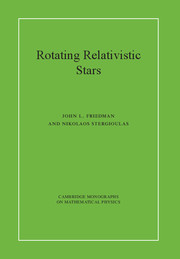Book contents
- Frontmatter
- Dedication
- Contents
- Preface
- List of symbols
- Conventions, notation, and mathematical preliminaries
- 1 Stationary, axisymmetric equilibria
- 2 3+1 split, action, Lagrangian, and Hamiltonian formalisms
- 3 Asymptotics, virial identities, and nonaxisymmetric equilibria
- 4 Numerical schemes
- 5 Equilibrium models
- 6 Approximation methods for equilibria
- 7 Perturbation theory of relativistic fluids
- 8 Quasinormal modes
- 9 Stellar stability
- 10 Nonlinear dynamics of rotating relativistic stars
- Appendix A Lie derivatives, forms, densities, and integration
- Appendix B The Newtonian limit of the two-potential formalism
- Bibliography
- Index
10 - Nonlinear dynamics of rotating relativistic stars
Published online by Cambridge University Press: 05 July 2013
- Frontmatter
- Dedication
- Contents
- Preface
- List of symbols
- Conventions, notation, and mathematical preliminaries
- 1 Stationary, axisymmetric equilibria
- 2 3+1 split, action, Lagrangian, and Hamiltonian formalisms
- 3 Asymptotics, virial identities, and nonaxisymmetric equilibria
- 4 Numerical schemes
- 5 Equilibrium models
- 6 Approximation methods for equilibria
- 7 Perturbation theory of relativistic fluids
- 8 Quasinormal modes
- 9 Stellar stability
- 10 Nonlinear dynamics of rotating relativistic stars
- Appendix A Lie derivatives, forms, densities, and integration
- Appendix B The Newtonian limit of the two-potential formalism
- Bibliography
- Index
Summary
In a multitude of astrophysical contexts in which a rotating relativistic star evolves about or away from an equilibrium configuration, linear perturbation theory does not adequately describe the star's evolution. Obvious examples are dynamical rotational instabilities; instability to collapse, leading to the formation of a rotating black hole; formation of compact stars after core bounce; and the large-amplitude oscillations of supramassive neutron stars that survive briefly after the merger of a double neutron-star system. In all these cases, a numerical treatment of the full Einstein equations is required, using the techniques developed in the field of numerical relativity. For CFS-unstable modes, nonlinear Newtonian perturbation theory has been used to find the saturation amplitude governing the perturbations; however, the nonlinear behavior of modes of rapidly rotating relativistic stars has so far been explored using fully nonlinear evolution codes. Even the linear modes themselves have been efficiently found by fully nonlinear evolutions of initial data describing small perturbations from equilibrium: Numerically solving the eigenvalue problem for outgoing normal modes of rotating stars has proved to be more difficult.
Both the modeling of rotating spacetimes with matter and the modeling of black-hole spacetimes with collapsing matter sources in multidimensions have been challenging tasks in numerical relativity. Nevertheless, through the adoption of advanced numerical techniques, several obstacles have been overcome. The difficulties encountered in such simulations can be traced back to inherent difficulties and complexities of the Einstein-Euler system, as well as the large computational resources needed for multidimensional simulations.
- Type
- Chapter
- Information
- Rotating Relativistic Stars , pp. 304 - 348Publisher: Cambridge University PressPrint publication year: 2013



